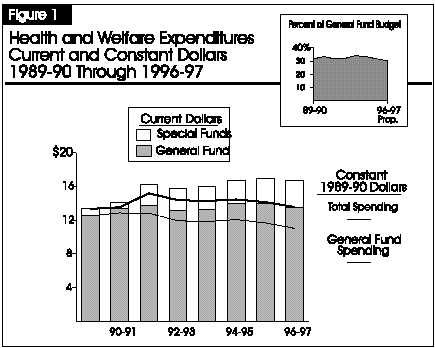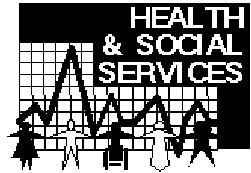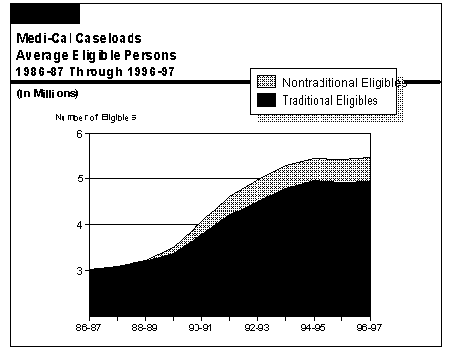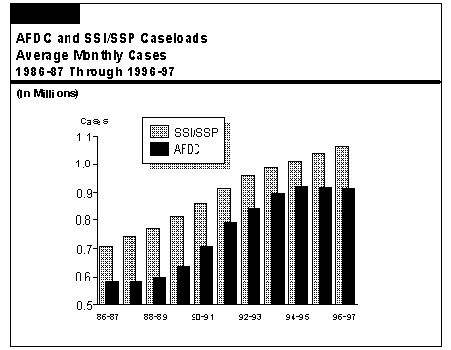

General Fund expenditures for health and social services programs are proposed to decrease by about 3 percent in the budget year. Most of this reduction is due to welfare grant reductions and eligibility restrictions, and shifting state costs to the federal government.
The budget proposes General Fund expenditures of $13.5 billion for health and social services programs in 1996-97, which is 30 percent of total proposed General Fund expenditures. The budget proposal represents a reduction of $424 million, or 3 percent, from estimated expenditures in the current year.
Figure 1 (see next page) shows that General Fund expenditures for health and social services programs are projected to increase by $1.1 billion, or 8.5 percent, between 1989-90 and 1996-97. This represents an average annual increase of 1.2 percent.
General Fund expenditures increased significantly until 1991-92, when realign ment legislation shifted $2 billion of health and social services program costs from the General Fund to the Local Revenue Fund, which is funded through state sales taxes and vehicle license fees. This shift in funding accounts for the significant increase in special funds starting in 1991-92, as shown in Figure 1. General Fund spending declined in 1992-93, due to various program reductions (the largest being welfare grant reduc tions). As discussed below, the budget proposes additional General Fund reductions in 1996-97.
Combined General Fund and special funds spending is projected to increase by 25 percent between 1989-90 and 1996-97. This represents an average annual increase of 3.2 percent.

Figure 1 also displays the spending for these programs adjusted for inflation. On this basis, General Fund expenditures are estimated to decrease by 12 percent between 1989-90 and 1996-97. Combined General Fund and special funds expenditures are estimated to increase by 1.5 percent during the same period, on a constant dollar basis. This is an average annual increase of less than 1 percent.
As noted previously, the 1991 realignment legislation significantly altered the financing of health and social services programs by transferring funding for all or part of several mental health, public health, and social services programs to the counties. The sales tax and vehicle license fee revenues dedicated to realignment amounted to $2 billion in 1991-92, which was $239 million short of the amount that was initially estimated. The budget estimates that realignment revenues will be $2.5 billion in 1996-97.
Figures 2 and 3 (see next page) illustrate the caseload trends for the largest health and welfare programs. In both programs, significant increases coincide with the onset of the recession in 1990. Figure 2 shows the Medi-Cal caseload growth, broken out by "traditional" eligibility categories--primarily Aid to Families with Dependent Children (AFDC) and Supplemental Security Income (SSI)/State Supplementary Program (SSP) recipients--and "nontraditional" eligibles--groups recently made eligible by state and federal law, including newly legalized immigrants, undocumented persons, and pregnant women.

Figure 2 shows there was a significant upswing in the rate of increase in the Medi-Cal caseload, beginning in 1989-90. This occurred primarily because of rapid growth in both the AFDC Program and in the nontraditional categories of Medi-Cal recipients. (For a more detailed discussion of this caseload growth, please refer to our Analysis of the 1992-93 Budget Bill, page V-90.)
Figure 3 shows the caseload trend for the AFDC (Family Group and Unemployed Parent[FG&U]) and SSI/SSP Programs. While the number of casesin the SSI/SSP Program is greater than in the AFDC Program, there are more personsin the AFDC Program--about 2.7 million compared to about 1 million for SSI/SSP. (SSI/SSP cases are reported as individual persons, while AFDC cases are primarily families.)

Caseload growth in these two programs is due, in large part, to the growth of the eligible target populations. The increase in the rate of growth in the AFDC caseloads in 1990-91 and 1991-92 was partly due to the effect of the recession. Subsequently, the caseload continued to increase but at a slower rate of growth. This slowdown, according to the Department of Finance, was due partly to (1) certain population changes, including lower migration from other states, and (2) a lower rate of increase in "child-only" cases (including citizen children of undocumented and newly legalized persons), which was the fastest growing segment of the caseload until 1993-94. (For a discussion of other factors affecting the AFDC caseload, please see our report on the program in The 1991-92 Budget: Perspectives and Issues, page 189.)
Figures 2 and 3 also reflect the budget's projections that AFDC and Medi-Cal caseloads will begin to decline slightly in the current year. As we discuss in our report, California's Fiscal Outlook(November 1995), we believe that these trends are due largely to various factors affecting welfare caseloads, including the improving economy, lower birth rates for young women, and a decline in legal immigration to California.
The SSI/SSP caseload can be divided into two major components: the aged and the disabled. The aged caseload generally increases in proportion to increases in the eligible population--age 65 or older. This component of the caseload accounts for about one-third of the total. The larger component--the disabled caseload--has been growing faster than the rate of increase in the eligible population group (primarily ages 18 to 64). This is due to several factors, including (1) the increasing incidence of AIDS-related disabilities, (2) changes in federal policy that liberalized the criteria for establishing a disability, (3) a decline in the rate at which recipients leave the program (perhaps due to increases in life expectancy), and (4) expanded state and federal outreach efforts in the program.
Figure 4 (see page 10) shows expenditures for the major health and social services programs in 1994-95 and 1995-96, and as proposed for 1996-97. As shown in the figure, the three major benefit payment programs--Medi-Cal, AFDC, and SSI/SSP--account for a large share of total spending in the health and social services area.
|
Figure 4 Major Health and Welfare Programs Budget Summarya 1994-95 Through 1996-97 (Dollars in Millions) |
|||||
|---|---|---|---|---|---|
| Actual 1994-95 | Estimated 1995-96 | Proposed 1996-97 | Change From 1995-96 |
||
| Amount | Percent | ||||
| Medi-Cal | |||||
| General Fund | $6,036.8 | $6,074.2 | $6,247.3 | $173.1 | 2.8% |
| All funds | 14,904.3 | 14,929.5 | 15,342.2 | 412.7 | 2.8 |
| AFDC (FG&U) | |||||
| General Fund | $2,814.9 | $2,602.9 | $2,073.0 | $-529.9 | -20.4% |
| All funds | 5,851.6 | 5,557.5 | 4,893.1 | -664.4 | -12.0 |
| AFDC (FC) | |||||
| General Fund | $272.4 | $319.7 | $332.5 | $12.8 | 4.0% |
| All funds | 1,138.8 | 1,253.8 | 1,300.7 | 46.9 | 3.7 |
| SSI/SSP | |||||
| General Fund | $2,017.7 | $1,952.6 | $1,577.8 | $-374.8 | -19.2% |
| All funds | 5,321.7 | 5,452.0 | 5,084.6 | -367.4 | -6.7 |
| County welfare administration | |||||
| General Fund | $423.3 | $473.8 | $496.9 | $23.1 | 4.9% |
| All funds | 1,682.2 | 1,870.7 | 1,912.4 | 41.7 | 2.2 |
| In-Home Supportive Services | |||||
| General Fund | $226.8 | $232.3 | $301.7 | $69.4 | 29.9% |
| All funds | 881.0 | 927.9 | 972.2 | 44.3 | 4.8 |
| Regional centers | |||||
| General Fund | $539.0 | $410.4 | $460.7 | $50.3 | 12.3% |
| All funds | 839.8 | 946.3 | 1,037.9 | 91.6 | 9.7 |
| Developmental centers | |||||
| General Fund | $33.1 | $33.0 | $30.5 | $-2.5 | -7.6% |
| All funds | 581.6 | 570.5 | 526.2 | -44.3 | -7.8 |
| Child welfare services | |||||
| General Fund | $178.0 | $283.8 | $354.6 | $70.8 | 24.9% |
| All funds | 785.3 | 936.0 | 1,025.8 | 89.8 | 9.6 |
| State hospitals | |||||
| General Fund | $160.4 | $209.6 | $238.6 | $29.0 | 13.8% |
| All funds | 405.1 | 474.3 | 484.6 | 10.3 | 2.2 |
| a Excludes departmental support. | |||||
| Figure 5 Health Services Programs Proposed Major Changes for 1996-97 General Fund |
||||||
|---|---|---|---|---|---|---|
| Medi-Cal | Requested: | $6.2 billion | ||||
| Increase: | $173 million | (+2.8%) | ||||
| ||||||
| Public Health | Requested> | $313 million | ||||
| Increase: | $4.1 million | (+1.3%) | ||||
|
| ||||||
| Figure 6 Social Services Programs Proposed Major Changes for 1996-97 General Fund |
||||||
|---|---|---|---|---|---|---|
| AFDC (FG&U) | Requested: | $2.1 billion | ||||
| Decrease: | $530 million | (-20%) | ||||
| SSI/SSP | Requested> | $1.6 billion | ||||
| Decrease: | $375 million | (-19%) | ||||
| Child Welfare Services | Requested> | $355 million | ||||
| Increase: | $71 million | (+25%) | ||||
Figures 5 and 6 (see pages 11, 12) illustrate the major budget changes proposed forhealth and social services programs in 1996-97. Generally, the major changes can be grouped into the following categories:
The budget proposes numerous changes in the health and social services area that depend on federal legislation or federal waiver of regulations. As Figure 7 shows, these proposals, in conjunction with previous budget actions requiring federal approval, amount to state savings of $495 million in 1995-96 and $1.5 billion in 1996-97. Federal legislation which would accomplish these savings is being considered in Washington, D.C.
We discuss the federal legislation to reform the welfare and Medicaid programs later in this Analysis.
The Governor proposes legislation to redesign the welfare system, effective July 1997. Under the proposal, the AFDC Program would be replaced by four separate programs. The major features of the proposal are as follows:
Eligibility.As is currently the case, families would have to include a child under age 18 and would have to be low-income, based on a yet unspecified income and asset test. Eligibility would generally be based on "fairness and equity with low-income working families," and using this guideline a "work equivalency benchmark" (analogous to the current "need standard") would be established. Also, the existing restrictions on the eligibility of two-parent families would be eliminated. (Currently, to be eligible for the AFDC-U Program, the principal wage earner must be unemployed when applying for aid and must have had a work history, based on specified criteria.)
Grants.The current grant structure, which increases with family size, would be replaced by a flat grant (the amount has not yet been specified). Actual grant amounts would essentially be based on the work equivalency benchmark, less recipients' income (employment earnings, for example), up to the maximum flat grant amount. Thus, recipients who work could, in effect, keep their earnings to the extent that the amount of earnings plus the grant do not exceed the work equivalency benchmark.
New Programs.The four proposed programs are:
|
Figure 7 State Savings Dependent on Federal Action Health and Social Services Programs Governor's Budget (Dollars in Millions) |
|||
|---|---|---|---|
| Budget Proposal | 1995-96 | 1996-97 | Two-Year Total |
| Previous Budget Actions | |||
| AFDC: | $22 | $44 | $66 |
| 1994-95 2.3 percent grant reduction | |||
| Regional 4.9 percent grant reduction | 20 | 58 | 78 |
| Statewide 4.9 percent grant reduction | 43 | -- | 43 |
| Maximum family grant | -- | 4 | 4 |
| Barring sponsored aliens | -- | 28 | 28 |
| SSI/SSP: | 25 | 101 | 126 |
| Regional 4.9 percent grant reduction | |||
| Statewide 4.9 percent grant reduction | 76 | -- | 76 |
| Eliminate drug/alcohol from SSI/SSP eligibilitya | -- | 6 | 6 |
| New Budget Proposals | |||
| Medi-Cal: | $216 | $303 | $519 |
| Federal funds for services to undocumented persons | |||
| Reduce nursing facility rates | -- | 26 | 26 |
| AFDC: | -- | 129 | 129 |
| Make 1995-96 statewide grant reduction (4.9%) permanent | |||
| 4.5 percent grant reduction | -- | 111 | 111 |
| Savings from federal block grant | 82 | 299 | 381 |
| Child support provisions (federal welfare reform) | 1 | -14 | -13 |
| Foster Care Emergency Assistance funds (federal welfare reform) | 4 | 8 | 12 |
| Child Welfare: | 5 | -32 | -27 |
| Savings/costs from federal block grant | |||
| SSI/SSP: | 1 | 90 | 91 |
| Deny benefits to noncitizensa | |||
| Restrict children's eligibility | -- | 6 | 6 |
| Make 1995-96 statewide grant reduction (4.9%) permanent | -- | 309 | 309 |
| Totals | $495 | $1,476 | $1,971 |
| a Savings include effect on Medi-Cal Program. | |||
We will discuss the Governor's proposal in more depth in our analysis of the AFDC Program.
Return to LAO Home Page